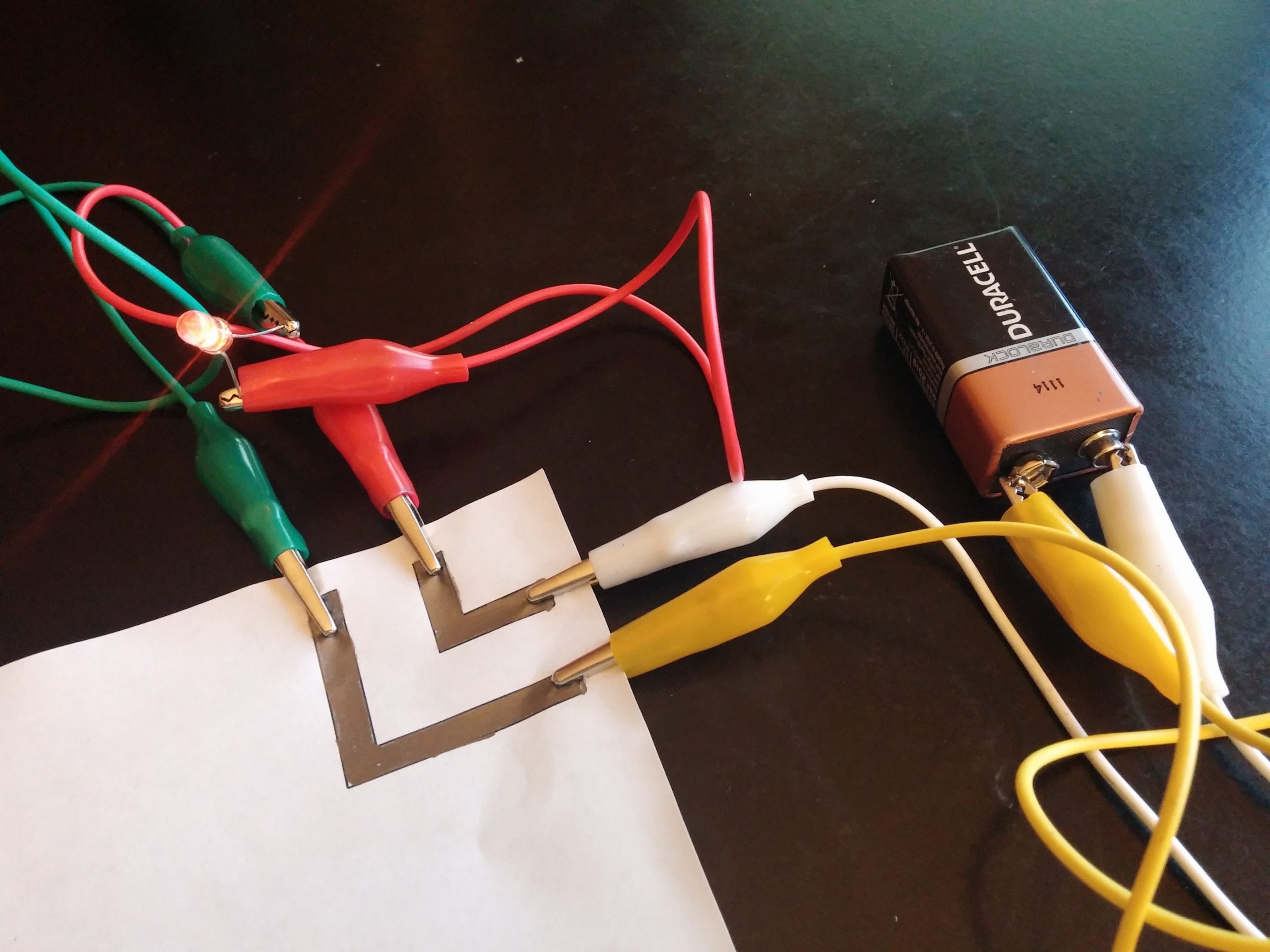
Students explore the conductive properties of graphite and graphene as they create simple circuits.
Question
Can thin layers of graphite conduct electricity?
Background
What we call “pencil lead” is actually a substance called graphite, which consists of many stacked sheets of carbon atoms. Like a metal, graphite is conductive and therefore can act like a wire on paper to create the circuit. Each sheet of carbon atoms is bonded in honeycomb structure and the single layers are known as graphene (see picture on front page or toy model; also if available, look under microscope at a real graphene flake!). These layers are very weakly bonded to one another, which allows them to easily slip past each other. Slide your finger along the box you drew; this is why it feels slippery! Resistance can be measured with a multimeter. The unit of resistance is the ohm. Resistance increases with the length of the conductor.
Research Connection
Scientists and engineers have recently been able to extract single two-dimensional (2D) layers of graphite (graphene) and study its extraordinary properties. In addition, we’ve now learned that there are many other layered materials that can be thinned down to the 2D sheets, only a few atoms thick. Researchers at MEMC are creating 2D materials in addition to graphite which have special properties at the nano-scale which could be used for energy efficient electronics, and batteries. There are 2D metals, insulators, semiconductors, superconductors, magnetic materials, ferroelectric materials, and more, all of which can be re-stacked in any combination like Legos!
NGSS Standards
| Standard Number | Standard text |
| 4-PS3-2 | Make observations to provide evidence that energy can be transferred from place to place by sound, light, heat, and electric currents. |
| 5-PS1-3 | Make observations and measurements to identify materials based on their properties. |
Materials
- Light-emitting diode (LED)
- 9 volt (9V) battery
- 2 AA batteries in a pack (~3V)
- 4 wires (with alligator clips on each end)
- Graphite pencil
- Eraser
- Multimeter (with test leads)
- Worksheet paper
Procedure
- Testing the LED
- Take the 3 V battery and touch the two wire ends simultaneously to the two LED leads. Does the LED light up? Note: It’s a good practice to place a small resistor in series with the LED to limit the flow of current and prevent it from being burned out with a 9V battery.
- Try flip flopping the LED leads. Does it light up now?
Explain: The LED should light up in one direction, but not the other. This is an important characteristic of a light-emitting diode; current must flow in a particular direction to get light production. In this case, current flows into the long LED wire and out the short one. If the LED does not light with the battery in either direction, the LED is likely burnt out, so try a new one.
- Take out one of the AA batteries from the pack and try hooking it up to the LED. What happens?
Explain: Nothing should happen! This is another very important property of an LED. There is a minimum voltage required to conduct electricity, which in this case is ~1.8 V, greater than the voltage of the single AA battery. - Draw your first circuit!
- Get out the worksheet paper. Use the graphite pencil to completely shade in boxes in the upper left corner of page 1. Make sure to press down hard enough so that the boxes are shiny with graphite.
- Take a wire and clip it to the positive terminal of the 9 V battery. Repeat with another wire and the negative terminal.
- Clip the opposite ends of these two wires to the boxes on one edge of the paper.
- Clip two more wires to the two leads of the LED and then clip the opposite ends to the boxes on the other edge of the paper. Does the LED light up? If not, flip the LED wires. Congrats, you’ve drawn a circuit.
Explain: A complete circuit includes an energy source and a load that are connected by wires arranged in a circle.
- Experiment!
- Use the eraser to rub through one of the boxes in part B. Watch what happens to the LED. Re-draw the erased part and watch the LED.
- Replace the 9 V battery with the AA batteries. Does it still light up? How does the brightness compare to the 9 V cases?
- Use your pencil to draw a line between the two boxes. What happens? If nothing seems to happen, progressively darken the line and continue to watch the LED and note what happens. Now erase the line that you drew. What happens? Think about what might be going on.
Explain: When you erased through the box, you effectively cut the graphite wire and current no longer had a path to flow through the circuit, so the LED turned off. In order to get the LED to light up, we need a sufficient amount of current to flow through it. In addition, higher current will increase the LED brightness. With the lower voltage of the AA batteries, less current flows through the LED and thus the brightness decreases. - Explore electrical resistance.
- Shade in the thin boxes with the dashed lines in section D (top right of page) of the worksheet.
- Connect a circuit with these graphite wires as you did in section B. Note the brightness of the LED.
- Hypothesize! What do you think will happen if you shade in the thicker box outlined by solid lines? First, measure the resistance between the ends of the long thin box using the multimeter.
- Leave the circuit connected and shade in the solid lines. Did the LED brightness change? Why? Measure the resistance between the ends of the big box and compare to the previous value.
Explain: As you should have noticed, the brightness of the LED increased after filling in the solid lines. This is because the resistance of the graphite drawing decreases with increasing surface area, allowing more current to flow through the circuit.
- Shade in the long thin boxes at the bottom right of the page.
- Place the 9 V battery upside down standing on the leads, connected to the boxes.
- Touch the LED wires to the opposite end of the thin box drawing to get it to light up. What do you think will happen if you slide the LED closer to the battery? Why?
- Slowly slide the LED closer to battery (but do not touch the battery and LED directly – it will destroy the LED) and note what happens. How does the brightness change?
Explain: The brightness of the LED should increase as it gets closer to the battery because the resistance of the graphite strips is proportional to their length. When the LED is far away, there is higher resistance in the graphite and thus less current overall in the circuit. Test the resistance of the graphite strip using the multimeter. Vary the distance between the multimeter leads and note how the resistance changes. Bonus question: does the brightness of the LED appear to increase linearly as it is moved closer to the battery? - Create! Use the remaining corner (or a new blank piece of paper) to test your own experiments. For example, look at how the resistance and brightness changes with multiple paths, try a different hardness of pencil lead, or experiment with pen instead of pencil. If you’re feeling artsy, make a cool drawing with a built-in circuit. For example, can you draw a circuit lighthouse with the LED light at top? Be creative!
Extensions
Try making conductive paint by mixing powdered graphic with clear acrylic paint as a binder. You can also purchase wire glue that is used for making non-soldered electrical connection.



